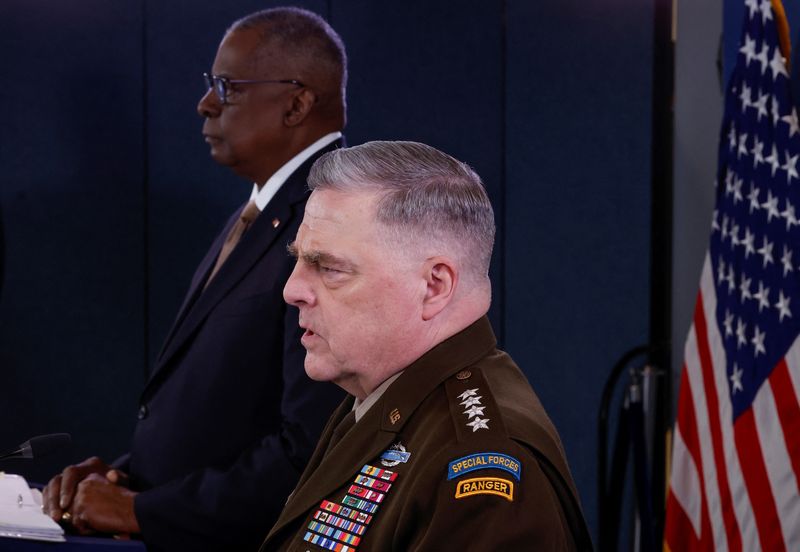By Idrees Ali and Phil Stewart
WASHINGTON (Reuters) -A U.S. surveillance drone brought down over the Black Sea after a Russian military intercept probably broke apart and would be difficult to recover given the depth of the water in the area, the top U.S. general said on Wednesday.
In the first direct U.S.-Russian incident since the Ukraine war began, a Russian Su-27 jet struck the propeller of the unmanned MQ-9 drone, making it inoperable, the Pentagon said, worsening already tense relations between Washington and Moscow.
Russia's defense ministry blamed "sharp maneuvering" by the drone for the crash and said its jet did not make contact.
"It probably sank to some significant depths, so any recovery operation from a technical standpoint would be very difficult," Chairman of the Joint Chiefs of Staff General Mark Milley told reporters.
He cautioned that it would take several days before the United States would know for certain the size of the debris field in waters as deep as 4,000 to 5,000 feet (1,219 to 1,524 meters), Milley said.
Russia said on Wednesday it would try to retrieve the remains the drone but appeared to acknowledge the challenges.
"I don't know whether we will be able to retrieve it or not, but that it has to be done. And we'll certainly work on it. I hope, of course, successfully," Kremlin Security Council Secretary Nikolai Patrushev told the Rossiya-1 TV channel.
Milley said the United States had already taken measures to guard against a loss of sensitive intelligence if the drone were to be recovered by Russia.
"We're quite confident that whatever was of value is no longer of value," Milley said.
INTENTIONAL OR NOT?
The incident over international waters on Tuesday was a reminder of the risk of direct confrontation between the United States and Russia over Ukraine, which Moscow invaded more than a year ago and which Western allies have supported with intelligence and weapons.
Milley said it was clear that the intercept and harassment of the drone by Russian jets was intentional, but it was unclear whether the Russian pilots meant to slam their aircraft into the MQ-9 -- a move that could also put the Russian aircraft at risk.
"Was it intentional or not? Don't know yet," Milley said.
Earlier on Wednesday, U.S. State Department spokesperson Ned Price said the incident was likely unintentional.
"I think the best assessment right now is that it probably was unintentional. It probably was the result of profound incompetence on the part of one of these Russian pilots," Price said.
Milley spoke with his Russian counterpart, Chief of the General Staff Valery Gerasimov, in a rare phone call on Wednesday, the Pentagon said.
U.S. Defense Secretary Lloyd Austin also spoke with his Russian counterpart, Sergei Shoigu, on Wednesday after the incident, but he declined to offer any details on his call at a news conference -- including whether he criticized the Russian intercept.
The restraint appeared to be an effort to preserve a rarely used U.S. communications channel with Moscow.
The State Department on Tuesday summoned Russia's ambassador to the United States, Anatoly Antonov, to express U.S. concerns over the encounter.
"The message that we delivered to the Russian ambassador is that they need to be more careful in flying in international airspace near U.S. assets that are, again, flying in completely legal ways, conducting missions in support of our national security interests," White House spokesperson John Kirby told CNN. "They're the ones that need to be more careful.

Antonov after the meeting said the drone "deliberately and provocatively was moving toward Russian territory with transponders turned off."
He said his meeting at the State Department was constructive and the issue of possible consequences for Moscow over the incident was not raised, RIA state news agency reported.
